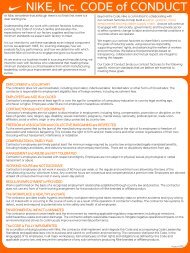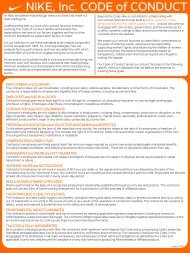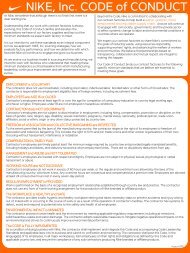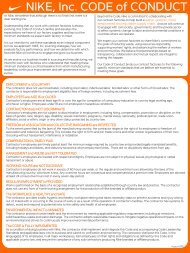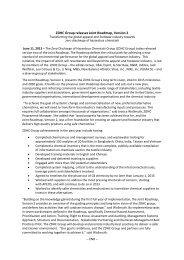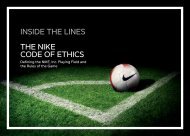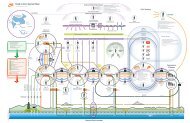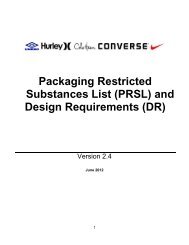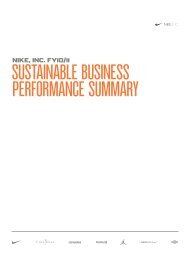COC CLS - Healthy Safety Environment - NIKE, Inc. - The Journey
COC CLS - Healthy Safety Environment - NIKE, Inc. - The Journey
COC CLS - Healthy Safety Environment - NIKE, Inc. - The Journey
Create successful ePaper yourself
Turn your PDF publications into a flip-book with our unique Google optimized e-Paper software.
PERSONAL PROTECTIVE EQUIPMENT (PPE)<br />
b. PPE is donned as per appropriate use applications and does not impact an additional risk.<br />
c. All personal protective clothing and equipment must be of safe design and construction for the<br />
work to be performed and must be maintained in a sanitary and reliable condition. Only those<br />
items of protective clothing and equipment that meet NIOSH (National Institute for<br />
Occupational <strong>Safety</strong> & Health) ANSI (American National Standards Institute) or Country<br />
standards may be procured or accepted for use. Newly purchased PPE must conform to the<br />
updated ANSI or Country standards (when applicable), as follows:<br />
• Eye and face protection:<br />
- Prevention of eye injuries requires that all persons who may be in eye hazard areas<br />
wear protective eyewear. This includes employees, visitors, researchers, third parties,<br />
or others passing through an identified eye hazard area. To provide protection for<br />
these personnel, contractors must procure a sufficient quantity of goggles and/or<br />
plastic eye protectors that afford the maximum amount of protection possible. If<br />
these personnel wear their own glasses, they must be provided with suitable eye<br />
protection to wear over them.<br />
- Suitable protectors must be used when employees are exposed to hazards from<br />
flying particles, molten metal, acids or caustic liquids, chemical liquids, gases or<br />
vapors, bio-aerosols, or potentially injurious light radiation.<br />
- Contact lenses wearers must also wear appropriate eye and face protection<br />
devices in a hazardous environment.<br />
- Side protectors must be used when there is a hazard from flying objects.<br />
- Goggles and face shields must be used when there is a hazard from chemical splash.<br />
- Face shields must only be worn over primary eye protection (safety glasses and<br />
goggles).<br />
- For employees who wear prescription lenses, eye protectors must either incorporate<br />
the prescription in the design or fit properly over the prescription lenses.<br />
- Equipment fitted with appropriate filter lenses must be used to protect against light<br />
radiation. Tinted and shaded lenses are not filter lenses unless they are marked or<br />
identified as such.<br />
• Head protection:<br />
- Head protection must be furnished to, and used by, all employees and contractors<br />
engaged in construction and other miscellaneous work.<br />
- Head protection is also required to be worn by engineers, inspectors, and visitors at<br />
construction sites when hazards from falling or fixed objects or electrical shock are<br />
present.<br />
<strong>Safety</strong> <strong>CLS</strong> – Page 2<br />
04.14.10



